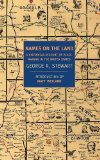Book Review: "Names on the Land" by George R. Stewart
January 20, 2009
It’s a new year and this year’s reading focus is on enjoyment, exploration and care–not quantity. I had been feeling good about my 75 books of last year until I heard today on the New York Times Book News podcast that George W. Bush and Karl Rove had a reading contest and Bush read 96 books in a single year. Real books. While in office. And Rove read more. How can this be?
This is not the first time I have read Stewart’s opus about place naming in North America. In college I took a course in historical geography. I remember two things about the course: that the classroom was near the seismograph in Cramer Hall (one of my favorite places to wander past), and this book. The way that people express their cultural shape through naming has always intrigued me. Much of Stewart’s theory was foundational enough that it stuck with me during the decade between that class and my recent re-reading: the types of place naming (transplantation of old names, adopting forms of native names, names describing events or attributes, biographical naming); trends in naming (colonial towns almost universally named after British counterparts, then post-Revolution rejection of English terms, then embracing of down-home American naming and Romantic notions). He traces the linguistic roots of name pieces (town-name-emes?) that we take for granted: -hurst, -glen, -ville.
A book that could easily have read like a laundry list of towns and rivers is instead an adventure. Stewart comes across as one of the last of a dying breed: born in the 19th century, he projects an aura of pith helmets and wooden drawers full of collected specimens. He recaps centuries of expanding frontiers from a vantage (the first edition came out between the wars) where those frontiers had finally bumped up against oceans. The age of heady exploration and gentlemanly academic pursuit was waning. Stewart’s tone is both poetic and wistful. It imparts an engaging enthusiasm.
Names on the Land, though a carefully-researched (and vast-flung) labor of love, does suffer from its age. I noted a few inaccuracies, including his claim for how Pompey’s Pillar (Montana) got named. Modern accounts explain that Pompey was the nickname of Sacagawea’s son. Stewart, however, posits that “The [then] current classical furor and the love of the republican heroes may account for Pompey’s Pillar.” Much discussion is had over the origin of the naming of Oregon, and Stewart leans toward a sloppy map engraver misspelling or transposing a version of “Wisconsin.” This theory is still in the mix, but has fallen slightly out of favor.
Stewart is masterful at weaving the stories of the cultures that influenced the names on our land. He traces the Spanish era of California and the Southwest. He gives a romp of an account of the French explorers Jolliet and Marquette, who, in the course of a summer’s paddling trip, established some of the greatest names of the central continent: Missouri, Kansas, Iowa, Omaha, Arkansas, others. He follows the ebbs and flows of popularity: pro-French naming after the Revolution, classical revival, mellifluous and “proper” names of the Victorian era. He shows a soft spot for the rustic and honest names of the mountains and the west.
Take this sentence as an epitome of the book’s character: “Deathball Creek in Oregon originated from the attempt of an amateur cook to make biscuits.” You can sense Stewart’s tongue-in-cheek affection for the rough-and-tumble pioneer naming style, yet once again a slight inaccuracy is unearthed: McArthur’s Oregon Geographic Names (a source I’ll call more reliable with respect to Oregon-specific names) cites the feature as Deathball Rock (not Creek).
This book sticks with you if you are of the right inclination. It has a strong sui generis feel to it. It will always maintain a safe, revered position on my bookshelf.
Related Posts
- Town Names
April 30, 2007 - Reader Question: How much does quantity matter?
February 4, 2010 - Book Review: “Histories” by Herodotus (Landmark)
January 3, 2010 - Book Projects for 2010
December 21, 2009 - Riding with Hitler
June 30, 2005

